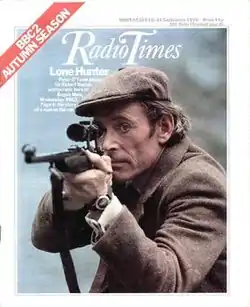Rogue Male (1976 film)
Rogue Male is a 1976 British television film starring Peter O'Toole, based on Geoffrey Household's novel Rogue Male. Made by the BBC, it was adapted by Frederic Raphael, directed by Clive Donner and also stars Alastair Sim, John Standing and Harold Pinter. It was first transmitted on 22 September 1976.
| Rogue Male | |
|---|---|
 | |
| Based on | Rogue Male by Geoffrey Household |
| Screenplay by | Frederic Raphael |
| Directed by | Clive Donner |
| Starring | |
| Composer | Christopher Gunning |
| Original language | English |
| Production | |
| Producer | Mark Shivas |
| Cinematography | Brian Tufano |
| Editor | Dan Rae |
| Camera setup | Single camera |
| Running time | 100m |
| Production company | BBC |
| Release | |
| Original network | BBC Two |
| Original release | 22 September 1976 |
Plot
In early 1939, before the start of the Second World War, Sir Robert Hunter (O'Toole) takes aim at Adolf Hitler with a hunting rifle, but hesitates to shoot and is spotted and tackled by a Schutzstaffel (SS) guard. Captured and tortured by the Gestapo, he is left for dead but manages, with the aid of a friendly sailor, to make his way back to England. He discovers that German agents are after him and believes that the government would turn him over to German authorities. Sir Robert goes underground, literally, to escape his pursuers, who are intent on getting him to sign a false confession that he attempted to assassinate Hitler while working for British intelligence.
Cast
- Peter O'Toole as Sir Robert Hunter
- John Standing as Major Quive-Smith
- Alastair Sim as The Earl
- Harold Pinter as Saul Abrahams
- Michael Byrne as Interrogator
- Mark McManus as Vane
- Ray Smith as Fisherman
- Hugh Manning as Peale
- Robert Lang as Jessel
- Cyd Hayman as Rebecca
- Ian East as Muller
- Philip Jackson as 1st Seaman
- Nicholas Ball as 2nd Seaman
- Maureen Lipman as Freda
- Ray Mort as Gerald
- Michael Sheard as Hitler
- Shirley Dynevor as Eva Braun
- Ivor Roberts as Drake
- John Ringham as SS Officer
Background
The novel had been filmed in 1941 by Fritz Lang, as Man Hunt, with Walter Pidgeon in the lead role.[1]
According to producer Mark Shivas, script editor Richard Broke had the idea of making six TV movie thrillers for the BBC which showed the changing nature of the British hero from 1918 to 1939, with Rogue Male to be the last. Shivas was then working on an adaptation of The Glittering Prizes with writer Frederic Raphael and commissioned him to adapt Rogue Male. Raphael went back to the novel and ignored the 1941 film. Shivas felt there were three things any version of Rogue Male had to have, the attempted assassination of Adolf Hitler at the beginning of the story, the chase on the London Underground and the battle underground at the end. Filming took 25 days and involved 29 locations.[2] Shivas would make two others in the series, She Fell Among Thieves and The Three Hostages.[2]
Interviewed by the Radio Times for the first screening of the film, Household acknowledged that he always intended the protagonist's target to be Hitler, "Although the idea for Rogue Male germinated from my intense dislike of Hitler, I did not actually name him in the book as things were a bit tricky at the time and I thought I would leave it open so that the target could be either Hitler or Stalin. You could take your pick".[3]
It was reported that Peter O'Toole had agreed to be cast in Rogue Male partly because the original novel was a favourite of his wife Sian Phillips.
Production
Some of the filming took place around King's Stag in Dorset, including the area around a local pub, the "Green Man".
As a TV production, the film was made on a relatively tight budget and the crew was paid at the lower rates applicable to TV productions.
Release and reception
Despite its low budget, the finished film was regarded by the BBC as being suitable for a cinema release internationally. This had the potential to cause legal and industrial problems in the UK, because the crew had not been paid at the rate applicable to cinema releases. The BBC decided to terminate screenings in the UK and disallow future screenings in the UK. In an interview with Francine Stock for BBC Radio 4's Film Programme in 2007, Peter O'Toole named the film as his favourite among those that he had made.[4]
References
- "Rogue Male". BFI. Archived from the original on 14 January 2009. Retrieved 26 November 2014.
- Television: An Interview with Mark Shivas Hodgson, Clive. London Magazine18.1 (Apr 1, 1978): 68.
- Radio Times, 18–24 September 1976, page 4.
- "BBC Radio 4 - The Film Programme, Peter O'Toole". BBC. Retrieved 26 November 2014.
External links
- Rogue Male at IMDb